| In the 12 peer-reviewed scientific studies summarized below, researchers found that liberals and conservatives have different brain structures, different physiological responses to stimuli, and activate different neural mechanisms when confronted with similar situations. Each entry below references the source document and a PDF of each study has been included. The studies are arranged from most recent to oldest. |
1. Conservatives spend more time looking at unpleasant images, and liberals spend more time looking at pleasant images.
 "We
report evidence that individual-level variation in people's
physiological and attentional responses to aversive and appetitive
stimuli are correlated with broad political orientations. Specifically,
we find that greater orientation to aversive stimuli tends to be
associated with right-of-centre and greater orientation to appetitive
(pleasing) stimuli with left-of-centre political inclinations."
"We
report evidence that individual-level variation in people's
physiological and attentional responses to aversive and appetitive
stimuli are correlated with broad political orientations. Specifically,
we find that greater orientation to aversive stimuli tends to be
associated with right-of-centre and greater orientation to appetitive
(pleasing) stimuli with left-of-centre political inclinations."
Michael D. Dodd, Amanda Balzer, Carly Jacobs, Michael Gruszczynski, Kevin B. Smith, and John R. Hibbing, "The Left Rolls with the Good; The Right Confronts the Bad. Physiology and Cognition in Politics,"  Philosophical Transactions of the Royal Society B: Biological Sciences, Mar. 5, 2012
Philosophical Transactions of the Royal Society B: Biological Sciences, Mar. 5, 2012
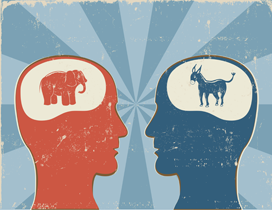 |
Four studies support our assertion that low-effort thinking promotes political conservatism... Our findings suggest that conservative ways of thinking are basic, normal, and perhaps natural."
Scott Eidelman, Christian S. Crandall, Jeffrey A. Goodman, and John C. Blanchar, "Low-Effort Thought Promotes Political Conservatism,"  Society for Personality and Social Psychology, 2012
Society for Personality and Social Psychology, 2012
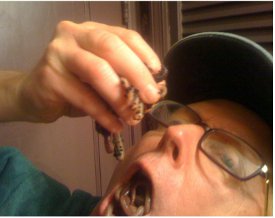 |
"People
who believe they would be bothered by a range of hypothetical
disgusting situations display an increased likelihood of displaying
right-of-center rather than left-of-center political orientations…
In this article, we demonstrate that individuals with marked
involuntary physiological responses to disgusting images [measured by
change in mean skin conductance], such as of a man eating a large
mouthful of writhing worms, are more likely to self-identify as
conservative and, especially, to oppose gay marriage than are
individuals with more muted physiological responses to the same images."
Kevin B. Smith, Douglas Oxley, Matthew V. Hibbing, John R. Alford, and John R. Hibbing, "Disgust Sensitivity and the Neurophysiology of Left-Right Political Orientations,"
|
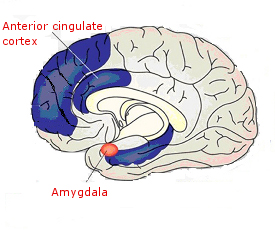 |
"In a large sample of young adults, we related self-reported
political attitudes to gray matter volume using structural MRI [magnetic
resonance imaging]. We found that greater liberalism was associated
with increased gray matter volume in the anterior cingulate cortex,
whereas greater conservatism was associated with increased volume of the
right amygdala... ...[O]ur findings are consistent with the proposal that political orientation is associated with psychological processes for managing fear and uncertainty. The amygdala has many functions, including fear processing. Individuals with a larger amygdala are more sensitive to fear, which, taken together with our findings, might suggest the testable hypothesis that individuals with larger amagdala are more inclined to integrate conservative views into their belief systems... our finding of an association between anterior cingulate cortex [ACC] may be linked with tolerance to uncertainty. One of the functions of the anterior cingulate cortex is to monitor uncertainty and conflicts. Thus it is conceivable that individuals with a larger ACC have a higher capacity to tolerate uncertainty and conflicts, allowing them to accept more liberal views."
Ryota Kanai, Tom Feilden, Colin Firth, and Geraint Rees, "Political Orientations Are Correlated with Brain Structure in Young Adults,"
|
5. Conservatives have stronger motivations than liberals to preserve purity and cleanliness.
 "...[R]eminders
of physical purity influence specific moral judgments regarding
behaviors in the sexual domain as well as broad political attitudes...
"...[R]eminders
of physical purity influence specific moral judgments regarding
behaviors in the sexual domain as well as broad political attitudes......[E]nvironmental reminders of physical cleanliness shifted participants’ attitudes toward the conservative end of the political spectrum and altered their specific attitudes toward various moral acts... When taken together, these two sets of results point to the possibility that political orientation may be, in some measure, shaped by the strength of an individual’s motivation to avoid physical contamination and that resulting vigilance for threats to purity may serve to reinforce a politically conservative stance toward the world."
Erik G. Helzer and David A. Pizarro, "Dirty Liberals! Reminders of Physical Cleanliness Influence Moral and Political Attitudes,"  Psychological Science, Mar. 18, 2011
Psychological Science, Mar. 18, 2011
6. Liberals follow the direction of eye movements better than conservatives.
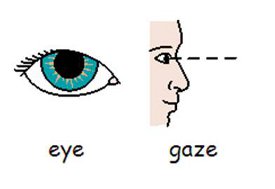 |
"In the present study, we examine whether gaze cue effects [the
ability to follow the direction of another individual’s eye movements or
gaze] are moderated by political temperament, given that those on the
political right tend to be more supportive of individualism—and less
likely to be influenced by others—than those on the left. We find
standard gaze cuing effects across all subjects, but systematic
differences in these effects by political temperament. Liberals exhibit a
very large gaze cuing effect while conservatives show no such effect at
various SOAs [stimulus onset asynchrony]... Perhaps conservatives are less likely to trust others meaning that they are also less likely to trust a gaze cue..."
Michael D. Dodd, John R. Hibbing, and Kevin B. Smith "The Politics of Attention: Gaze Cuing Effects Are Moderated by Political Temperament,"
|
7. Republicans are more likely than Democrats to interpret faces as threatening and expressing dominant emotions, while Democrats show greater emotional distress and lower life satisfaction.
 "Independent
sample t-tests revealed group differences in the averaged threat
interpretation scores of the 10 facial stimuli. Republican sympathizers
were more likely to interpret the faces as signaling a threatening
expression as compared to Democrat sympathizers. Group differences were
also found for dominance perceptions, whereby Republican sympathizers
were more likely to perceive the faces as expressing dominant emotions
than were Democrat sympathizers...
"Independent
sample t-tests revealed group differences in the averaged threat
interpretation scores of the 10 facial stimuli. Republican sympathizers
were more likely to interpret the faces as signaling a threatening
expression as compared to Democrat sympathizers. Group differences were
also found for dominance perceptions, whereby Republican sympathizers
were more likely to perceive the faces as expressing dominant emotions
than were Democrat sympathizers...Collectively, when compared to Republican sympathizers, Democrat sympathizers showed greater psychological distress, more frequent histories of adverse life events such as interpersonal victimization experiences, fewer and less satisfying relationships, and lower perceptions of the trustworthiness of peers and intimate affiliates."
Jacob M. Vigil, "Political Leanings Vary with Facial Expression Processing and Psychosocial Functioning,"  Group Processes & Intergroup Relations, 2010
Group Processes & Intergroup Relations, 2010
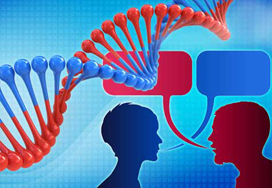 "The
present research attempts to characterize how the transmission of
political orientations develops over the life course... [G]enetic
influences on political attitudes are absent prior to young adulthood.
During childhood and adolescence, individual differences in political
attitudes are accounted for by a variety of environmental influences...
However, at the point of early adulthood (in the early 20s), for those
who left their parental home, there is evidence of a sizeable genetic
influence on political attitudes which remains stable throughout adult
life."
"The
present research attempts to characterize how the transmission of
political orientations develops over the life course... [G]enetic
influences on political attitudes are absent prior to young adulthood.
During childhood and adolescence, individual differences in political
attitudes are accounted for by a variety of environmental influences...
However, at the point of early adulthood (in the early 20s), for those
who left their parental home, there is evidence of a sizeable genetic
influence on political attitudes which remains stable throughout adult
life."
Peter K. Hatemi, Carolyn L. Funk, Sarah E. Medland, Hermine M. Maes, Judy L. Silberg, Nicholas G. Martin, and Lindon J. Eaves, "Genetic and Environmental Transmission of Political Attitudes Over a Life Time," The Journal of Politics, July 21, 2009
The Journal of Politics, July 21, 2009
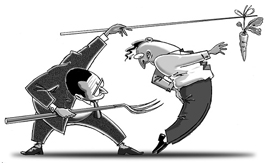 |
The reluctance to explore that characterizes more politically conservative individuals may protect them from experiencing negative situations, for they are likely to restrict approach to known positives."
Natalie J. Shook and Russell H. Fazio "Political Ideology, Exploration of Novel Stimuli, and Attitude Formation,"  Experimental Social Psychology, Apr. 3, 2009
Experimental Social Psychology, Apr. 3, 2009
 "In
a group of 46 adult participants with strong political beliefs,
individuals with measurably lower physical sensitivities to sudden
noises and threatening visual images were more likely to support foreign
aid, liberal immigration policies, pacifism, and gun control, whereas
individuals displaying measurably higher physiological reactions to
those same stimuli were more likely to favor defense spending, capital
punishment, patriotism, and the Iraq War. Thus, the degree to which
individuals are physiologically responsive to threat appears to indicate
the degree to which they advocate policies that protect the existing
social structure from both external (outgroup) and internal
(norm-violator) threats."
"In
a group of 46 adult participants with strong political beliefs,
individuals with measurably lower physical sensitivities to sudden
noises and threatening visual images were more likely to support foreign
aid, liberal immigration policies, pacifism, and gun control, whereas
individuals displaying measurably higher physiological reactions to
those same stimuli were more likely to favor defense spending, capital
punishment, patriotism, and the Iraq War. Thus, the degree to which
individuals are physiologically responsive to threat appears to indicate
the degree to which they advocate policies that protect the existing
social structure from both external (outgroup) and internal
(norm-violator) threats."
Douglas
R. Oxley, Kevin B. Smith, John R. Alford, Matthew V. Hibbing, Jennifer
L. Miller, Mario Scalora, Peter K. Hatemi, and John R. Hibbing, "Political Attitudes Vary with Physiological Traits,"  Science, Sep. 19, 2008
Science, Sep. 19, 2008
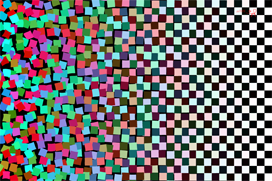 |
Dana R. Carney, John T. Jost, Samuel D. Gosling, and Jeff Potter, "The Secret Lives of Liberals and Conservatives: Personality Profiles, Interaction Styles, and the Things They Leave Behind,"  International Society of Political Psychology, Oct. 23, 2008
International Society of Political Psychology, Oct. 23, 2008
 "Our
results are consistent with the view that political orientation, in
part, reflects individual differences in the functioning of a general
mechanism related to cognitive control and self-regulation. Stronger
conservatism (versus liberalism) was associated with less neurocognitive
sensitivity to response conflicts. At the behavioral level,
conservatives were also more likely to make errors of commission.
Although a liberal orientation was associated with better performance on
the response-inhibition task examined here, conservatives would
presumably perform better on tasks in which a more fixed response style
is optimal."
"Our
results are consistent with the view that political orientation, in
part, reflects individual differences in the functioning of a general
mechanism related to cognitive control and self-regulation. Stronger
conservatism (versus liberalism) was associated with less neurocognitive
sensitivity to response conflicts. At the behavioral level,
conservatives were also more likely to make errors of commission.
Although a liberal orientation was associated with better performance on
the response-inhibition task examined here, conservatives would
presumably perform better on tasks in which a more fixed response style
is optimal."
David M. Amodio, John T. Jost, Sarah L. Master, and Cindy M. Yee, "Neurocognitive Correlates of Liberalism and Conservatism,"  Nature Neuroscience, Sep. 9, 2007
Nature Neuroscience, Sep. 9, 2007
No comments:
Post a Comment
Note: Only a member of this blog may post a comment.